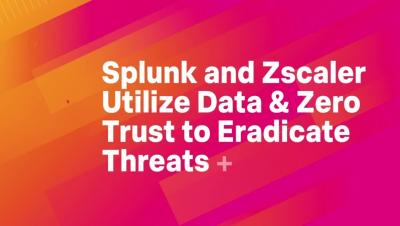Security | Threat Detection | Cyberattacks | DevSecOps | Compliance
Security
Splunk and Zscaler Utilize Data and Zero Trust to Eradicate Threats
SOARing w/ Splunk Phantom
A Look at a Zero Trust Strategy for the Remote Workforce
If you are new to the security world, it is fair to ask yourself, “Isn’t access to data and systems always conditional? Isn’t it always granted to someone who has access to the credentials (ID and password)?” True enough, but in totality, the approach to managing access encompasses a broader spectrum of privacy policies. These policies include a mix of different strategies that can be applied based on an organization’s security vulnerabilities.
Ransomware is the biggest threat, says GCHQ cybersecurity chief
The head of the UK’s National Cyber Security Centre has warned that ransomware has become the biggest threat to British people and businesses. In a speech being given today by Lindy Cameron, chief executive of the NCSC, to the RUSI think tank, she highlights the need for ransomware problem to be taken seriously, and warns of the “cumulative effect” if society fails to properly deal with the rising threat.
5 Risk Mitigation Strategies That Can Save Your Business Lots of Money
Businesses sit on massive, ever-growing piles of data. According to Dave Reinsel, senior vice president, IDC's Global DataSphere, 64.2 zettabytes (ZB) of data was created or replicated in 2020. And the amount of digital data created over the next five years will be greater than twice the amount of data created since the advent of digital storage. But data isn’t just growing, it is spreading to more applications, more users, and more devices than ever.
Is Slack Secure? Vulnerabilities and Solutions
Slack has become one of the most integral platforms for businesses over the last decade, with more than 12 million users currently active. Despite its popularity, however, there are some Slack security concerns that linger from the platform’s 2015 security breach. Here’s what you need to know about Slack security and how to protect your sensitive information on the platform.
Adversary emulation with Prelude Operator and Elastic Security
It’s no secret that organisations are up against skilled, relentless and determined adversaries. Security operations teams need to continuously test their detection capabilities by carrying out adversary emulation plans that are made up of varying tactics, techniques and procedures (TTPs) and track key metrics of their coverage in order to close any existing gaps. There are many tools available for running adversary emulation plans and performing purple team exercises.
Here's why your SaaS needs a DPA
While there may still be the occasional team that handles everything themselves, most software products are made up of a variety of services from different vendors. From data storage to customer management, third party data processors are a nearly unavoidable part of any organization.
New Devo report shows organizations how to embrace the cloud for better security outcomes
Devo recently published a new research report Beyond Cloud Adoption: How to Embrace the Cloud for Security and Business Benefits, based on a survey conducted by Enterprise Strategy Group (ESG). ESG surveyed 500 IT and security professionals working in the security operations center (SOC) chain of command at organizations with more than 1,000 employees in North America and Western Europe. The survey took place in the first quarter of 2021. This is the first in a series of posts about the report.










